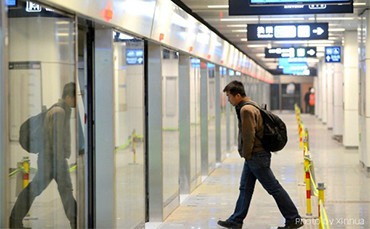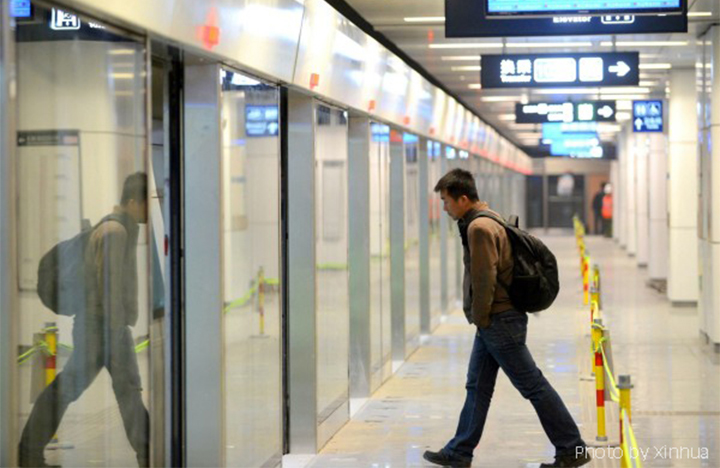



▲ A passenger on the Xiju station of Subway Line 14 in Beijing. [Photo/Xinhua]
1. Development Objectives.
Establish a resilient urban spatial governance system for the capital that is safe, reliable, flexible, quickly recoverable, well organized, and adaptable to the future.
1.1 Optimal operation and self-adaptation.
Strictly implement various planning measures in an orderly manner, so that in the face of medium to low-impact disaster risks, effective disaster response can be achieved through self-organization and self-adaptation to ensure that the basic operation of the city is minimally affected.
1.2 Strong defense and rapid recovery.
Construct defense facilities in vulnerable areas, so that in the face of high-impact disaster risks, timely and effective disaster prevention, mitigation, and relief should be achieved to ensure the urban operation is basically normal with rapid recovery.
1.3 Basic protection and serious maintenance.
Strengthen the effective support of the overall resilient urban spatial layout and various resilient measures, so that in the face of huge impact disaster risks, the operation of capital’s functions and important social functions should be ensured to protect people’s lives to the greatest extent while achieving comprehensive recovery in a scientific and orderly manner.
1.4 Planning Objectives.
By 2025, significant progress will be made in the construction of the resilient urban spatial governance system of the capital, the framework of the resilient urban spatial pattern will be initially formed, the critical weak links will be improved, the disaster-resistant capacity of critical infrastructure will be enhanced, and the resilience capabilities in key areas will be continuously strengthened.
By 2035, a resilient urban spatial governance system compatible with the status of the capital as a great modern socialist country will be basically established. A resilient urban spatial pattern with both maintenance and recovery capabilities and a resilient and secured urban lifeline system with mutual support and assistance will be formed. The vulnerable urban area will be basically eliminated, and the resilience capacity to extreme disaster risks will be comprehensively enhanced.
By 2050, a world-class resilient urban spatial governance system compatible with the status of the capital as a great modern socialist country will be fully built. Modernization of resilience planning and governance capabilities will be comprehensively achieved, and it will become a model resilient city with disaster maintenance capabilities, post-disaster recovery capabilities, and future transformative capabilities.
2. Layout Principles.
Enhance resilience in times of disaster with a diversified urban lifeline system at its core; improve post-disaster recovery capabilities with a focus on distributed resilient spatial layout; and boost future transformative capabilities through the construction of resilient community and village life circles.
3. Spatial Pattern.
3.1 Construct a collaborative and complementary resilience and security system in the Beijing-Tianjin-Hebei region.
Improve the top-level institutional framework for resilient urban construction in the Beijing-Tianjin-Hebei region to effectively ensure the safety of the capital. Strengthen regional resilience spatial support and infrastructure layout to achieve coordinated responses to disaster risks. Form a regional resilience transportation system that is mutually beneficial, coordinated, safe, reliable, and comprehensive, to maximize resilience capacity in times of disaster.
3.2 Improve the urban scale structure with resource and environmental adaptation capabilities.
Take the carrying capacity of resources and environment as a rigid constraint, and continuously enhance the adaptability of urban scale. Reduce risks in weak areas through land use reduction and building scale control.
3.3 Create an adaptive, diverse, and long-term spatial layout.
Adhere to the comprehensive spatial control of "two lines and three zones" (“two lines” refer to “ecological red line” and “urban development boundary’, “three zones” refer to “ecological control zone”, “concentrated construction zone” and “restricted construction zones”.) to consolidate ecological security patterns. Continuously optimize urban spatial patterns and strengthen adaptive risk prevention and control. Enhance the stability of urban ecosystems by continuously improving the urban green space structure. Promote underground space safety control and increase the diversity of resilient spatial carriers. Promote work-life balance to enhance production and life recovery response levels. Optimize and improve the layout of strategic reserve land to give future development flexibility.
3.4 Establish a citywide resilient urban support system with “three rings, eight corridors, and multiple nodes”.
Improve the urban open space system, coordinate the layout of urban safety facilities such as disaster prevention facilities and emergency transportation facilities, promote the integration of ecological networks and disaster prevention networks, strengthen the construction of urban lifeline projects, enhance the supply security of transportation trunk systems, and establish a resilient urban support system of "three rings, eight corridors, and multiple nodes" within the administrative region of the city.
“Three rings” refer to three resilient support rings, consisting of capital function guarantee ring, urban operation support ring, and Beijing-Tianjin-Hebei collaborative and integrated ring.
“Eight corridors” refer to eight resilient safeguard corridors, comprising comprehensive regional strategic resource supply channels and the national comprehensive transportation backbone.
“Multiple nodes” refer to multi-dimensional critical resilient guarantee nodes, including key facilities such as national and regional transportation hubs, major energy facilities, logistics bases, comprehensive emergency rescue bases, etc.
3.5 Strengthen the moderately redundant, multi-source, multi-directional, safe, and reliable lifeline security system.
Through the construction of moderately redundant urban operational systems, achieve full coverage and differentiated safety guarantee for the urban population. Strengthen the construction of urban lifeline systems to improve system diversity, self-adaptability, and dynamic adjustment capabilities. Continuously deepen the transportation structure, and enhance the security and reliability of transportation networks. Improve the layout of various safety facilities such as firefighting, public security, and emergency shelters to effectively enhance the capability of urban safety and security. Optimize the layout of medical and health facilities, and enhance the response levels of facilities in key and weak areas. Establish a multi-level, three-dimensional emergency transportation evacuation and rescue system. And promote the construction of a logistics facility system to enhance emergency response capabilities.
Source: <https://www.beijing.gov.cn/zhengce/zhengcefagui/202403/W020240325309081232801.pdf>
Edited and Translated by Guo Xinxin